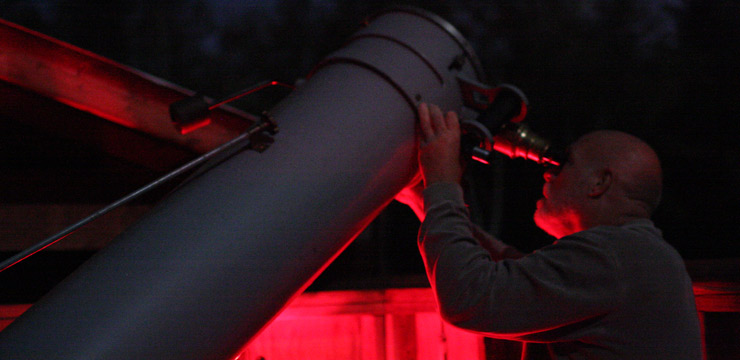An Observation of Comet C/2009 R1 (McNaught)
July 2010 :
Note: This article may contain outdated information
This article was published in the July 2010 issue of The Skyscraper and likely contains some information that was pertinent only for that month. It is being provided here for historical reference only.
Seems as if astronomers in this part of the country end up getting “skunked” more often than not, when we’d really like to view an important celestial object’s transient appearance. You know the formula, I think: clouds, rain, a bright Moon, something that sets too early or rises too late, an object’s low altitude above the horizon, maybe a new “killer” floodlight a neighbor just installed in exactly the worst possible position with respect to your best viewing direction, etc., etc. (Sound familiar?) I don’t believe in luck, but there’s no better word to describe the confluence of conditions that favored me on the morning of June 15, 2010. The consensus of opinion among various astronomical authorities held that mid-June would be the best time to see Comet C/2009 R1 (McNaught) from our local latitude. I knew the comet’s predicted position in Perseus and was aware of reports on its brightness and general appearance. I also checked my planisphere to determine the altitude above the northeast horizon for a given time period, and consulted a table so as to know when morning astronomical twilight would begin. Naturally, my chosen earliest time for realistic observing-3:00am-just about coincided with the beginning of the loss of darkness to twilight, about 3:05am. You can’t have everything, as is often said.
Still, the Moon was New just a few days prior and skies had been predicted to clear during late evening of June 14th, improving to all-clear for early morning of the 15th. My observing friend Tim Dube of East Douglas Massachusetts and I made tentative plans to set up for observing in Tim’s yard at 2:00am, subject to the cloud situation. We were delighted at seeing weather forecasts actually turn out as predicted. The sky cleared thoroughly after midnight, although you could feel some humidity--sky transparency wasn’t optimal, but the comet was in a favorable direction from our observing site with respect to both skyglow from Worcester and viewing obstructions involving buildings and trees. We had a good, clear sight line low to the northeast that also remains blessedly free of any unshielded, bright streetlights or other “glare-bombs” as Editor Jim Hendrickson likes to call such things.
I had that old feeling of pleased anticipation as I drove the route from my home in Oxford Massachusetts over rural roads to East Douglas. Tim had his 16-inch Dobsonian set up near the house when I arrived just after 2:00am. Unfortunately, we could not move it quickly or conveniently to a better position about 40 feet away, due to the scope’s size and weight (One pesky tree interfered with the sight line to central Perseus!) We ended up using Tim’s 8-inch Schmidt-Cassegrain scope on a handy alt-az mount to see the comet from a better vantage point after 3:00 am. The eyepiece he’d chosen was a 30mm Wide-Scan, which yields a magnification in the 8-inch of 68x.
Somewhere around 2:40am I trained a 10x50mm binocular on Delta Persei and almost immediately picked up the comet, glowing like a very bright and compressed, unresolved globular cluster with a distinct blue-gray color. No tail, either ion or dust, was discerned. The fortuitous position near Delta Persei made finding this comet a snap, although any savvy amateur with good information and a fair knowledge of Perseus could’ve located it equally easily, due to its conspicuous brightness. I’m not the best estimator of magnitude; the comet may have been roughly magnitude 5.0, according to some reports, and 5.3 or so might be a better guess(?). We switched to a hand-held 15x70mm binocular for further viewing-still no sign of a tail.
Tim and I used his 8-inch SCT from 3:10 to about 3:35am for our best views, which revealed a not-quite distinct false nucleus within the head. No other features or structures were noted, including a tail. I’m sure others elsewhere saw the ion tail at different times during the comet’s apparition-did any of you? I did note definite movement over about a half-hour’s time in relation to a 3-star asterism nearby. The change in position was unmistakable!
Related Topics




